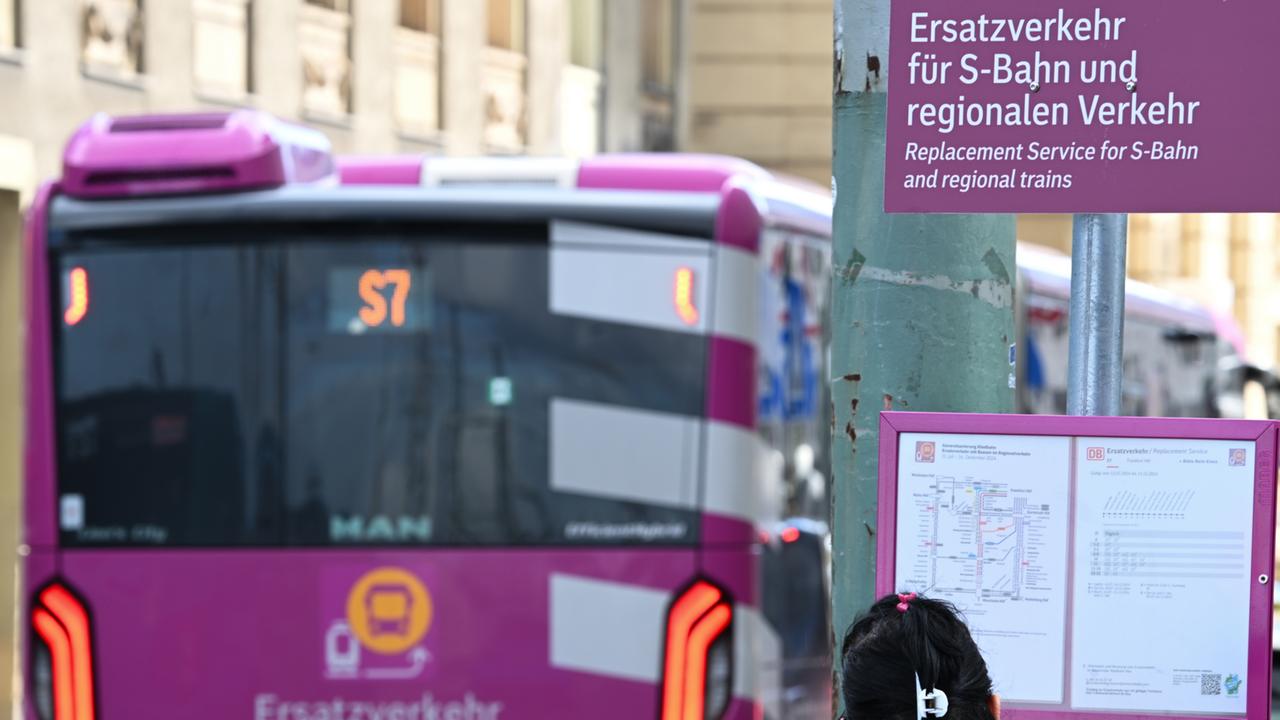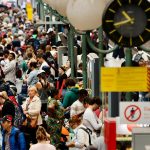report
Instead of trains, only buses currently run between Frankfurt and Mannheim. How much does this test the nerves of commuters?
At the beginning of this week, shortly after 7 a.m.: We are standing at the replacement bus stop in Gernsheim and waiting for the “RE 70” to take us to Frankfurt. The “S7” bus pulls up, a man in a green vest jumps out and calls out “Good morning! S7 to Frankfurt.” So we get on. An hour and three quarters later, we are at Frankfurt Central Station, 50 kilometers away. Seated, dry, cool and well shaken. Anyone who has to take replacement buses should be immune to motion sickness.
It is not easy to drive the large articulated buses on country roads through southern Hesse. Even well-developed federal highways are now interrupted by roundabouts. The “S7” has 13 regular stops along the way and a few more that the friendly bus driver stops at in addition. Wolfskehlen is on the regular schedule: winding into the village, winding through the village, picking up a new passenger at the station and winding out again. The passengers are shaken, not stirred.
Commuters need longer
The “RE 70” bus would have been a better choice: only four stops at the beginning and then a half-way trip on the motorway to Frankfurt. That takes an hour and 15 minutes. If the route is not closed until mid-December due to ongoing major renovations, a regional express train (RE 70) takes 40 minutes. That's why Gernsheim is attractive for commuters: live in the medium-sized city on the Rhine and earn money in Frankfurt.
Only beginners and people who want to travel short distances and from place to place use the “S7”. In the evening we take the replacement bus “RE 70” for the journey home. It is on time.
There is not much going on in any of the four buses we tried out today. There are between a handful and two dozen passengers per bus. In the current holiday season with little traffic, the timetable works perfectly.
There is space for luggage and strollers. Many buses have a toilet on board, which is more spacious than in coaches and in a perfectly usable condition. All seats have seatbelts, which hardly anyone uses. It is tight for tall people. Between Mörfelden and Walldorf a Lufthansa plane crosses the blue sky, and the replacement bus passenger reflects: It is no more uncomfortable here than up there.
Difficult Customer information
On the journey home, the “real-time journey information” that the train advertises so much is switched off. Customers no longer know when they will arrive where. This may be because the train is having difficulty with the technology. On a test journey during the day towards Mannheim, the information system showed that the first station, Goddelau, would be reached 49 minutes late. And that was when the station was already in sight, well ahead of schedule. The same phenomenon occurred on the return journey: Frankfurt was reached 48 minutes late. This is also nonsense; the bus arrived exactly on time.
Deutsche Bahn has traditionally found it difficult to get information that is available within the company to where it is important and of interest. All test drives show that the train app is generally not up to scratch. The times displayed are regularly incorrect. The app of the regional transport association RMV, which is otherwise more reliable, does not show some buses at all.
During our test runs, one bus did not arrive. The RE 70 from Frankfurt at 9:17 is and remains missing. The green vests at the stations report that this happens: sometimes a driver does not show up, sometimes a bus is broken, and sometimes no one knows. Their contact with the control center in faraway Berlin regularly does not provide any clarification. When asked about this, the train company denies any failures and praises the excellent coordination.
The staff is very helpful
400 drivers were hired for 150 brand new buses. Most of them are Poles, who speak decent English and poor German. People in green (“operational control”) and white vests (helpers) are on hand at many stations to help solve problems. Some buses have train conductors on board who have nothing to do because there is no train service.
The staff seem to be extremely friendly and try very hard. Our tickets were not checked the entire day.
The train leaves too early
Customers are well advised to arrive early. The drivers are quick and do something that is completely unthinkable in rail traffic: they like to set off too early. One minute ahead of schedule is common, two minutes rare. We measured three minutes once. During a 6:45 hour test drive, three curbs were hit, four deep yellow traffic lights were passed and a traffic island was on the ideal line, but in the opposite direction to the prescribed direction.
When approached in a friendly manner at the destination station, the driver is not interested in the conversation and sighs wearily: “I have a break now”.





